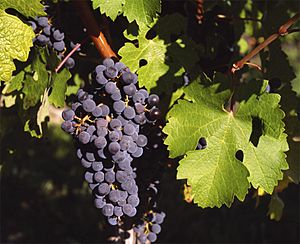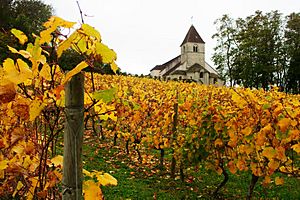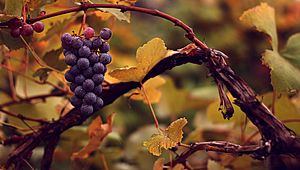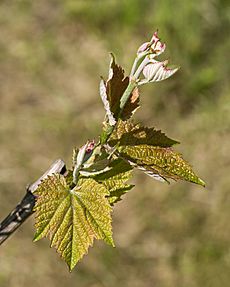Common grape vine facts for kids
Quick facts for kids Common grape vine |
|
|---|---|
 |
|
| Conservation status | |
| Scientific classification | |
| Genus: |
Vitis
|
| Species: |
vinifera
|
The common grape vine, also known as Vitis vinifera, is a type of flowering plant. It originally comes from the Mediterranean area, Central Europe, and southwestern Asia. You can find it from Morocco and Portugal all the way north to southern Germany and east to northern Iran.
There are between 5,000 and 10,000 different kinds of Vitis vinifera grapes today. However, only a few of these are important for making wine or for eating as table grapes.
Wild grape vines are often called Vitis vinifera sylvestris. Cultivated grape vines are known as Vitis vinifera vinifera. Domesticated vines have flowers with both male and female parts. Wild vines have separate male and female plants, so they need pollination to grow fruit.
Grapes can be eaten fresh or dried to make raisins, sultanas, and currants. Many cultures use grape leaves in their cooking. Fresh grapes can also be made into juice. This juice can then be fermented to create wine and vinegar. Most wines around the world are made from Vitis vinifera grapes. You can find these grapes grown on every continent except Antarctica, in all the main wine regions.
Contents
History of Grapes
Ancient Grapes
People started picking wild grapes during the Stone Age. For thousands of years, grapes have been used for both medicine and food. Their story is closely linked to the history of wine.
Scientists believe that grapes were first grown by people around 3500–3000 BC. This happened in southwest Asia, the South Caucasus region (like Georgia), or near the Western Black Sea shore (like Romania and Bulgaria). The oldest proof of cultivated grapes was found in Georgia, dating back to about 6000 BC.
Grapes in Ancient Times
Growing domesticated grapes spread to other parts of the Old World long ago. The first written stories about grapes and wine are in the Epic of Gilgamesh. This is an ancient text from Sumer from about 3000 BC.

Ancient Egyptian writings also mention wine. It was only for priests, government officials, and the pharaoh. The Greek writer Hesiod described grape harvests and wine-making in his book Works and Days.
Greek settlers brought these practices to their new lands, especially southern Italy. This area was even called Enotria, meaning "land of vines," because of its good climate. The Etruscans improved how wine was made. They also started selling wine to places outside the Mediterranean.
The ancient Romans learned from the Etruscans and made even more improvements. Many Roman books talk about grape growing, and some of their ideas are still useful today. However, during a difficult time for the Roman Empire (3rd and 4th centuries AD), less wine was made. It was mostly grown near towns and along the coasts.
Grapes in the Middle Ages
From the 5th to the 10th centuries, monasteries kept grape growing alive. Monks like the Benedictines helped grapes grow further north and in higher places than before. Rich families also grew grapes as a sign of their importance. Grape growing was a big business in the Middle East until the 7th century, when the expansion of Islam led to its decline.

Grapes in Modern Times
Between the late Middle Ages and the Renaissance, grape growing became popular again. More people living in towns and cities, and having more money, led to more investment in vineyards. Many books were written during the Renaissance about growing grapes and making wine. This helped start the modern study of grape varieties.
European settlers took grapes with them around the world. They arrived in North America around the 17th century, and also in Africa, South America, and Australia. In North America, European grapes mixed with native grape species. Some of these mixtures were made on purpose to fight a tiny insect called phylloxera. This pest badly damaged European grapevines. Later, American grape roots were used to protect European grape varieties from phylloxera.
Grapes Today
| NCBI genome ID | 401 |
|---|---|
| Ploidy | diploid |
| Genome size | about 500 Mb |
| Number of chromosomes | 19 pairs |
| Year of completion | 2008 |
| Sequenced organelle | plastid |
In the late 1900s, grape growing changed from old ways to a more scientific approach. This was due to new discoveries in science and changes in how people lived and what they wanted to buy. People started wanting better quality products.
In 2007, scientists fully mapped the genetic code of Vitis vinifera. This helped them understand how plants evolved and how the plant's genes affect the taste of wine. This project was a team effort between Italian and French researchers.
Also in 2007, Australian scientists found something amazing. They believe that tiny, rare changes in two genes of red grapes created a single white grapevine. This one white grapevine became the parent of almost all the white grape varieties we have today. Without these changes, most grapes would still be red!
What Does a Grape Vine Look Like?
The common grape vine is a liana, which is a woody vine. It can grow 12 to 15 meters (39 to 49 feet) tall very quickly. It has flaky bark. Its leaves grow in an alternating pattern and have 3 to 5 pointed sections. They are deciduous, meaning they fall off in autumn. The leaves are usually 5 to 20 cm (2 to 8 inches) long and wide. They are shiny dark green on top and lighter green underneath, usually without hairs.
The vine holds onto supports using thin structures called tendrils. The stems, called twigs, grow from their tips. A branch has several sections called internodes, separated by knots. Leaves, flowers, and tendrils grow from these knots. As the twigs get older, they become woody branches that can grow very long. The roots of a grape vine usually go 2 to 5 meters (7 to 16 feet) deep, and sometimes even deeper, up to 12–15 meters (39–49 feet).
Wild grape vines usually grow in wet forests and along streams.
Grape Flowers and Fruit
Grape flowers are small and greenish-white. They grow in groups called inflorescences. The fruits are berries, which we call grapes, and they also grow in clusters.
Wild grapes are dioecious, meaning male and female flowers grow on separate plants. But the grapes we grow for food and wine have both male and female parts on the same flower. This allows them to self-pollinate.
The fruit is a berry. Wild grapes are usually 6 mm (0.24 inches) wide and turn dark purple to black when ripe. Cultivated grapes are much larger, up to 3 cm (1.2 inches) long. They can be green, red, or purple (black).
Where Grapes Grow
Vitis vinifera grapes are used for most of the wine made around the world. All the well-known grape varieties used for wine come from V. vinifera.
You can find Vitis vinifera growing in many places:
- In Europe, mostly in the central and southern parts.
- In Asia, in western areas like Anatolia, the Caucasus, the Middle East, and in China.
- In Africa, along the northern Mediterranean coast and in South Africa.
- In North America, in California and other areas like Michigan, New Mexico, New York, Oregon, Washington state, British Columbia, Ontario and Québec.
- In South America in Chile, Argentina, Uruguay, Peru and Brazil.
- In Oceania in Australia and New Zealand.
Growing Grapes
People have been using grapes since the Stone Age. In 1996, scientists found 7,000-year-old wine storage jars in what is now northern Iran. This shows how long grapes have been important. The people of Mesopotamia and Ancient Egypt also grew grapevines and made wine.
Greek thinkers believed grapes and wine had healing powers. In China, Vitis vinifera cultivation and winemaking began in the 2nd century during the Han Dynasty. This was when the species was brought from Ta-Yuan. However, wild "mountain grapes" were used for wine before that time.
In traditional Indian medicine, V. vinifera is used for coughs, breathing problems, and liver issues. In the Mediterranean, people traditionally feed grape leaves and young stems to sheep and goats after trimming the vines.
Historically, European folk healers used grapevine sap to treat skin and eye diseases. Grape leaves were used to stop bleeding, pain, and swelling. Unripe grapes were used for sore throats, and raisins for tuberculosis, constipation, and thirst. Ripe grapes were used for treating cancer, cholera, smallpox, nausea, skin and eye infections, and kidney and liver diseases.
Seedless grapes were created because people liked them. But now, researchers are finding that many healthy benefits of grapes might come from the seeds themselves. This is because seeds are rich in special plant chemicals.
In Ayurveda, Vitis vinifera is often mixed with other herbs and spices to create special tonics. Grapevine leaves are also used to make a traditional Balkan dish called dolma. This dish involves filling the leaves with minced meat, rice, and onions.
In Australia, a popular type of grape vine called Vitis 'Ornamental Grape' is grown in gardens. It's known for its beautiful leaves that turn bright red, scarlet, purple, or orange in autumn. This plant was first grown in France and can grow well in many different climates and soil types.
Grape Chemistry
Vitis vinifera contains many natural compounds. For example, Anthocyanins are found in the skin of red grapes and give them their color. Other compounds called Stilbenoids are found in the skin and wood of the vine. One of these, resveratrol, is a natural defense the plant makes against certain fungi.
Grapes also contain other chemicals that give them their unique smells and flavors. These include compounds like linalool and geraniol. As grapes ripen, they develop Carotenoids. When these break down, they create strong-smelling compounds like ionone (which smells like violets) and damascenone (which smells like exotic fruits).
Interestingly, grape seeds are rich in healthy fats. These fats can help lower bad cholesterol levels in the blood.
Images for kids
See also
 In Spanish: Vitis vinifera para niños
In Spanish: Vitis vinifera para niños






